The Closer: Where Schoolies Beat the Skunk
When the hunt for big stripers begins to feel like work, go catch some schoolies and soothe the soul.
Last week was a banger. Fish—lots of them, for long stretches, and more than a few were big. No schoolies here. There was no low ebb in the action, no period requiring me to refocus, and no time casting when I felt I had to “stick it out.” It was just a furiously great handful of tides; a week I knew I could hang my proverbial motivational hat on through later, harder stretches. When the skunkings inevitably started to pile up, I knew I was going to be able to fall back on those nights for enthusiasm, dedication, and grit.
However, I was hoping that the harder stretches wouldn’t come so quickly. Tonight, I’m three hours into my third night of skunkings. The 20- and 30-pound fish of last week feel a world-away, and with a string of nights coming where I can’t fish at all, I’m getting desperate. I know I should stay for another hour because the best window hasn’t closed yet. I know I should remain steadfastly committed; consistency and grinding out tough patches is the way to 40 pounders. But I’m already outside the migration period (my favorite time for trophies) and the next few weeks might be intermittently frustrating. So my mind starts to succumb to temptation, and my focus wanes and slides away with the ebbing tide.
(Note: On The Water is reader-supported. When you buy through links on our site, we may earn an affiliate commission.)
I’m still casting, but I’m on autopilot, my consciousness is ruminating on tonight’s bonus stop. As I shift my feet around on my rock, I start to wonder if there will be as many fish as there were last week. I picture the current seam and try to imagine how it might be interacting with the small hump I know is on the bottom. It’s still a mystery to me exactly why the fish set up on the left side of it, but there’s no doubt it’s real. I’m lost inside my mind, dissecting that tiny piece of structure as minutes slip by. Suddenly, it’s been 15 minutes and I haven’t changed a plug, haven’t paid any attention to what I am doing, haven’t even tried casting in a different direction. Bad behavior—a signal that it’s time to go. I make one more cycle through a couple of plugs for good measure, reel up, and hustle back to shore.
While there were years when this would signify the end of the night—even the week— and a bitter feeling in my gut, I instead felt a glimmer of hope that the night might not be totally lost. There’s still a final closing round to soften the hard blow of my repeated blanks.
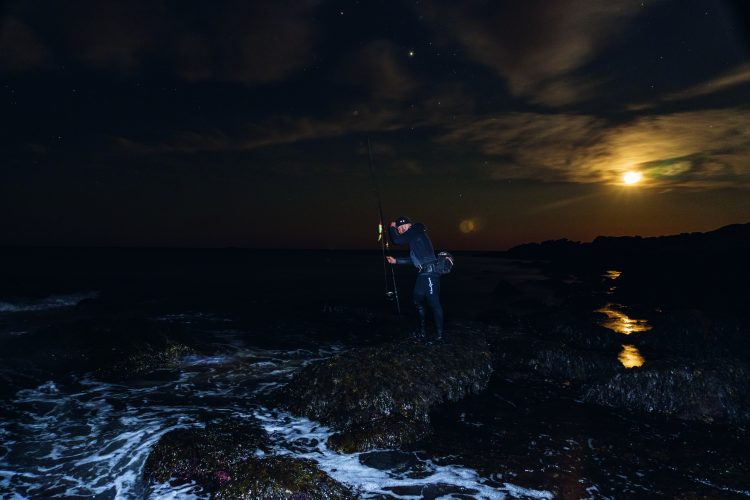
My goal as a surfcaster is to catch larger fish (those in the 25- to 45-pound range), so I’m used to long periods with little or no action. Not just no landings; I sometimes go long stretches with no hits. When hunting big fish, this is just part of the game. I enjoy experimenting, testing theories, and playing with different plugs, flies, and presentations. If I’m getting no hits and catching absolutely zero fish, then I have no opportunity to do any of those things. I need some feedback—I need some fish that are willing to feed.
That’s why a few years ago I started trying to incorporate “bonus” or “closer” spots into some nights. At the most basic, simple level, these are locations on my way home from trophy areas that are easy to get to. They are typically uncomplicated, some are not very glamorous, and few are well known. While these bonus spots look pretty diverse, they do have a few things in common that make them appeal to me when I want to close out the session with a half-hour of rod-bending action.
First, I typically look for “closer” spots that are action-packed, even if the fish are smaller. I’m always looking to catch the largest fish I can—whether I’m fishing in a famous place like Montauk or the trickle coming out of a culvert. I just accept that at the culvert, the fish might max out at 32 inches all season, so that becomes my target. But never underestimate the ability (and desire) of 15- to 25-pound stripers to swim into the smallest places.
The second thing I’m typically looking for is a little more complicated but boils down to this: Whatever my primary spot requires, I do almost the opposite at my “closer.” For example, if I have a primary spot that requires a wetsuit, a 10-foot rod, and lots of slow presentations, then I want my bonus spot to require only waders (or just boots) and perhaps some faster-paced glider or soft-plastic fishing. Or, maybe the closer will be a purely fly-rod spot, with very short casts using small shrimp patterns. These are just a couple of examples, but the point is that I often look for as much of a shake-up as possible from my night-in, night-out grind.
The final thing I look for is simplicity. I don’t want to be walking far, dealing with sketchy parking, or deep wading for hundreds of yards. If I’m on my way home and looking to bend a rod, I want to do as close-to-truck fishing as possible. This sometimes means dealing with other fishermen or fishing less desirable landscapes, but after a long, hard stretch of blanks, these things seem to matter a whole lot less to me. Plus, there are no stakes involved. If it’s boring, if I’m beaten to my favorite casting platform, or if I simply strike out again, I just continue on home.
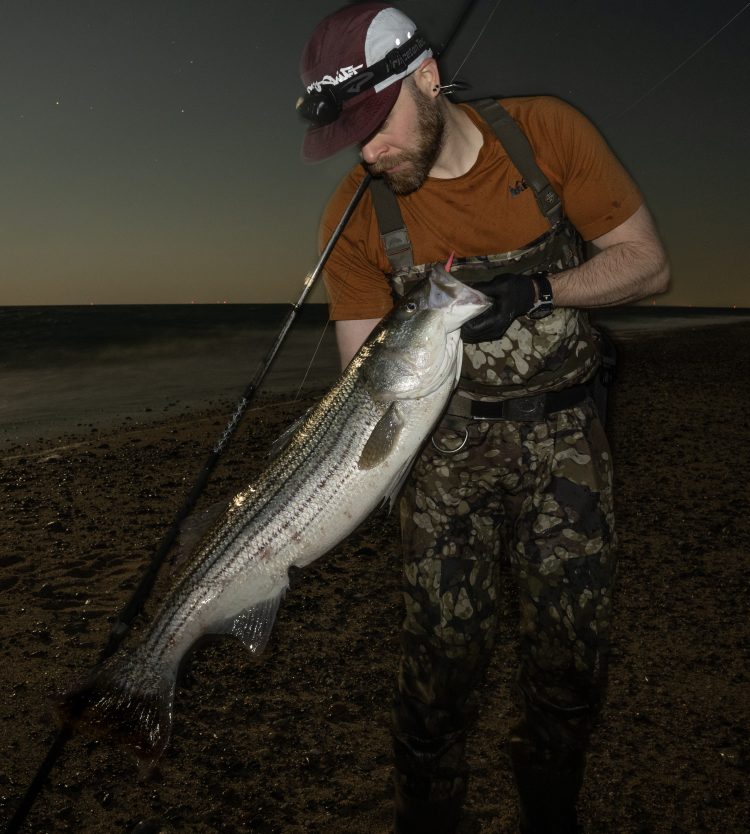
I’m still a little wet as I pull on my waders next to the buggy, despite the substantial drive from the boulder field I had blanked at earlier. There’s something really uncomfortable about pulling on waders when I’m still damp, but I can’t access the edge I like to target without them. I slide my wetsuiting bag off my belt and replace it with my bonus bag … the bag I keep in my car that covers the scenarios I find at my closers. There really isn’t a huge difference between the two, but it’s part of my ritual here at “Double Trouble.”
Double Trouble is a bonus spot on my way home that I named after a couple of anglers I’ve seen far too often. They always fish bait and seem to be doing everything they can to tangle themselves, me, the structure, or anything else in the area.
After a quick walk, I’m happy to find that no one is at Double Trouble tonight, so it’s all mine. I slide into the water and wade out to the edge; as I do, I hear fish popping sporadically in a huge arc. The seam and eddy have already set up. If this had been my primary destination, I’d be cursing myself for being much too late. Instead, I hardly give it a second thought. I pinpoint my first cast (with a Slug-Go on a light jighead) and fully anticipate a fish on my first drift. I lob the soft plastic out and it takes a bit longer than I anticipated, but at the very end of the drift as the rubber starts to rise, it’s nailed by a fish. The hit is jarring and wild, and the fish goes nuts on the surface. I horse it in and am content to have landed a 12- or possibly 14-pound fish on my first cast.
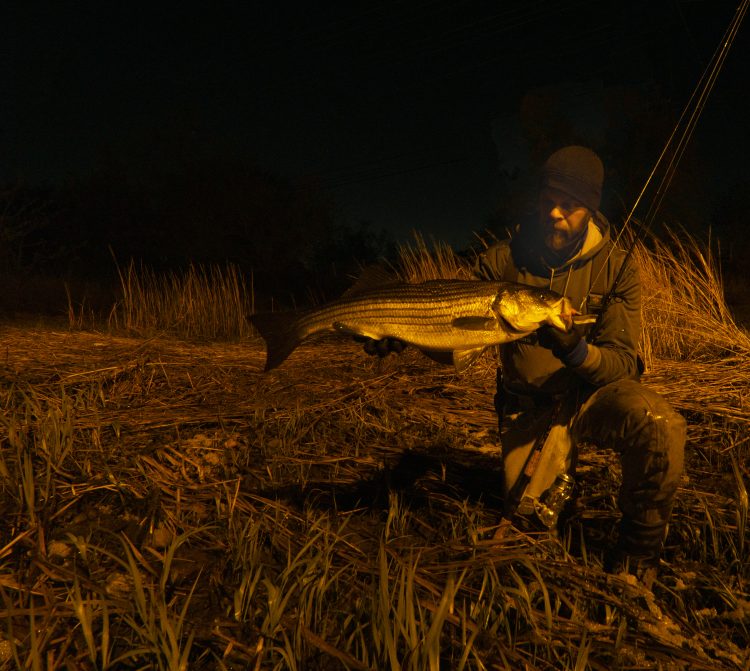
There are a couple of key ingredients that I think need to be present in a closer besides simplicity. First and foremost, I’m going to be targeting substantial, concentrated current moving from one body of water to another—striper nirvana. While my “bigger fish” spots all have current, they can be complicated. My bonus spots are typically straightforward: on one tide, for the entirety of that tide, the current moves in one direction. To help you envision what I mean, picture the jetty of a breachway with a back bay. That’s the kind of scenario I am looking for. Essentially, I want long stretches of time with significant moving water where bait is being flushed out, overwhelmed, or trapped.
Ideally, a closer also has a plethora of bait species. Unlike my main spots, I don’t care how big it is. I just want there to be a lot of consistent bait. I’d prefer it to be diverse; for example, I love high concentrations of minnows, shrimp, and crabs all mixed together. I think they represent different opportunities for fish to feed based on the conditions and the tide stage. Since they’re available during low- and high-current periods and when the water is both deep and shallow, the fish have reason to hang around for the entire tide. Relying on just one kind of bait—for example, menhaden, squid, or sand eels—is not consistent enough for a bonus spot, in my opinion.
If you line up other key factors like tide, temperature, moon, and wind, you may be surprised how consistently this grab-bag of small bait will draw fish in the 18- to 25-pound range. My hypothesis as to why these small baits still attract sizable fish under special conditions is simple: stripers are always looking for the easiest calories. While an adult bunker or tautog may be more bang for the buck, sometimes water conditions line up so perfectly that all a 20-pound fish has to do is sit in an eddy or channel with its mouth open and pounds of bait will get washed right in. It takes so little work for those fish that it’s worth it for them to stop harassing bunker or herring for the night and instead munch on some worms, shrimp, minnows, or crabs.
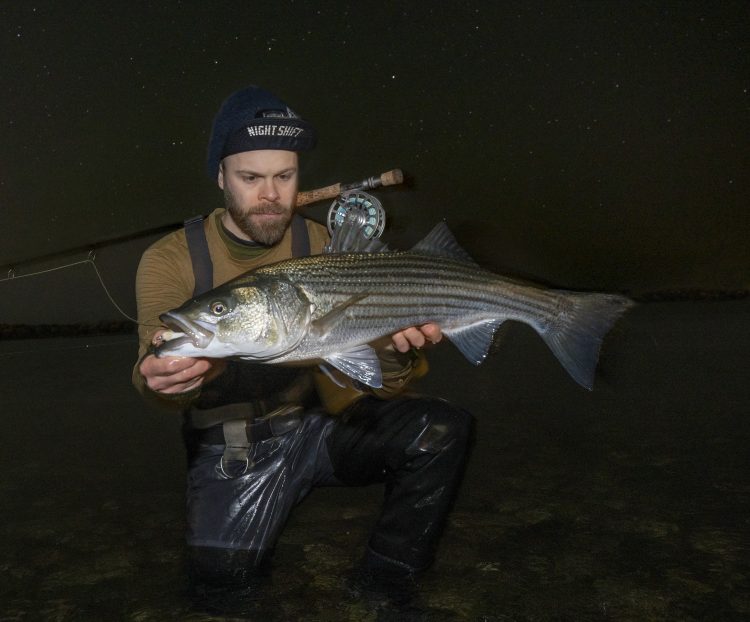
It’s almost 3:15 a.m. now. I know I should go home, but I keep thinking about my forced nights off coming up and the string of blasé fishing I had earlier this week. More importantly, for the last 90 minutes, it’s been a circus of rowdy fish that have hurled my soft plastics clean out of the water and fully breach as they commit to killing them. I have been experimenting with Savage Gear Dragon Tails, Gravity Tackle eels, and Keitech paddle tails. All have worked great, so that’s information I’ll store away for use later at primary spots. I’ve also tried out a couple of plugs with treble hooks, but it’s much easier for me to unhook these slot-sized fish on a jig, which makes it both more convenient and more humane.
I’m laughing a lot. These fish are hilarious rascals and savagely intent. When I hook one, sometimes after five hits, it invariably goes crazy on the surface. A few even jump and tail-walk, which is such a rarity for me when nighttime fishing. That alone is worth the minimal effort I’ve made to stop at Double Trouble. Another huge bonus.
It’s not always like this. Typically, it’s a few fish, maybe a dozen, in the first half-hour and then I’m ready to leave. They aren’t usually this “lit,” but tonight the moon is full. I may have been able to pull a 25-pound-plus fish from this school of teeners an hour ago, but that’s not the point. Had I been here then, I would have felt an unrelenting, heavy blanket of guilt for not focusing on the trophy tides. I had to put in that work to appreciate this bonus fishing … kind of like a big bowl of ice cream after a hard session at the gym.
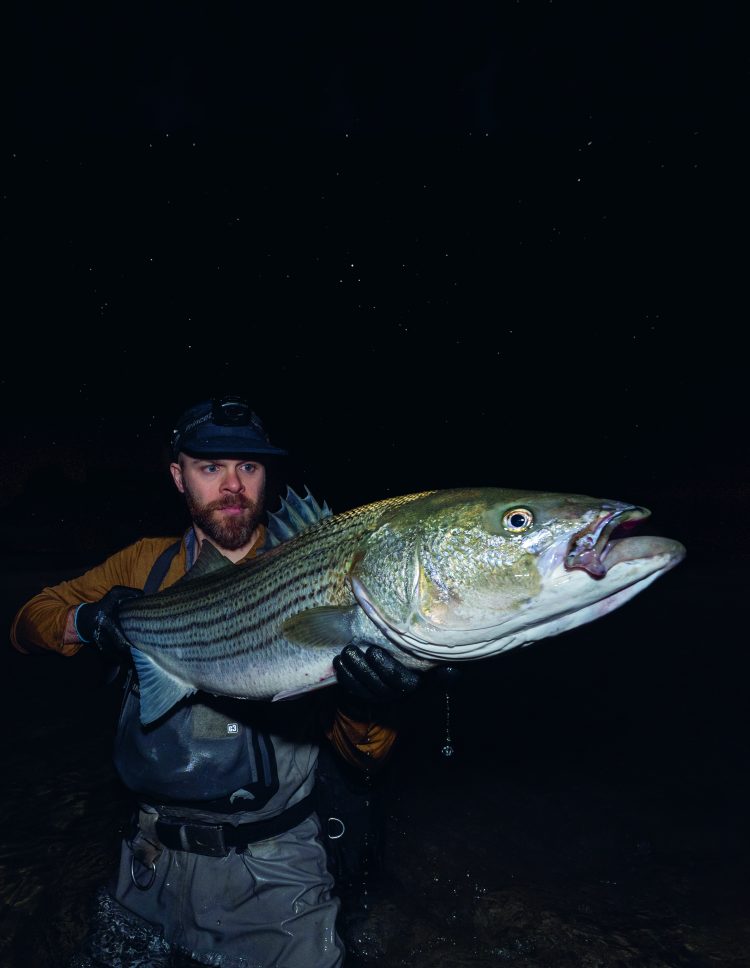
For my closer spots, I pack an entirely separate bag with basic all-arounders. It typically stays in my buggy, and I don’t obsess over constantly changing it. It always has 6-, 7.5-, and 9-inch Slug-Gos rigged in various ways (light jigheads and swimbait hooks), medium-sized plastic gliders like the 5.25-inch Yo-Zuri Twitchbait, a couple of Redfins, a few Super Strike Zig-Zags and Super N’ Fish, and one or two small surface metal lips. That bag covers everything from small minnows to adult menhaden.
I don’t go too light on my tackle. I almost always use a 9-foot-or-up rod and a 5000-size reel with 30-pound braid, though I occasionally size down to a robust 7-footer. I don’t want to be playing smaller fish on wimpy gear, but that’s not the primary reason I try to avoid light tackle. Instead, despite looking for action and accepting smaller fish, I’d be heartbroken to lose something special. I’d rather have less fight from more fish, and be ready for a season-changing moment, than the other way around.
I also encourage you to try out fly fishing at your closer. Sure, it’s a bit more work, and when you’re tired, it can be tough on the shoulders. However, it’s fun to have a totally different technique to look forward to, so it becomes a double bonus. And in the places I fish, using easy-to-cast flies works well in matching the most readily available baits. Just like with my plugs, I try to keep my closer fly arsenal super tight. A single small wallet or waterproof box filled with 3- to 6-inch baitfish patterns is all you need. Deceivers, flatwings, EPs, and low-riding deer-hair patterns are my staples. However, I’ve recently incorporated some crab and shrimp patterns into my repertoire and it’s been fun. I thought the fish would just gently slurp these small flies, but they can really nail them.
My fly tackle is always the same, closer or primary. A 10-weight and floating line are my go-tos because I don’t like to play schoolies, and I sometimes like to throw bigger flies in the current. The reel doesn’t matter at all for this. Even with 20-pound fish, I’ve yet to have one get more than 10 yards into my backing. Since almost any reel holds 100 yards of gel-spun backing and you need only a couple pounds of drag, anything will do. If this is new to you, don’t stress too much about the gear because fly fishing can feel complicated. Just get a strong rod, high-quality floating line, use a straight piece of mono as your leader, and bring along a handful of whatever flies look good to you.
I’m swinging my 7-inch Slug-Go through the current, feeling a twang of regret for not also grabbing my fly rod. Next time, no matter what, I have to! As I’m having these thoughts, the skinny plastic slides through the eddy and stops dead. There is weight that just gradually pulls the rod into a rainbow, but then there’s a lack of any further response for a few, very long seconds. Much better fish, I think as I haul back. In an utterly bewildering tactic, the fish cuts hard, straight toward me. This creates so much slack (despite me trying to catch up) that I immediately assume I’ve lost it. Then, jarringly, I come tight again as the fish veers right, but only for a second. My rod dips hard before I can regain my wits, and with a final surge, she’s off, and I’m stumbling backwards. I reel in the jig and see that the hook is partially deflected. It was simply too much, and my single loud curse startles a mallard that erupts from the water, quacking loudly in objection as it peels off into the sky.
It’s then I notice, as I unconsciously look up at the fleeing fowl, that the horizon is getting orange, with hints of rose. I look at my watch—it’s 4:25 am. I’ve been here for three hours! I reel up and immediately start the short walk back to the buggy. Losing fish is no fun, but this one is already forgotten: it was, after all, just a bonus fish.
Leave a Reply